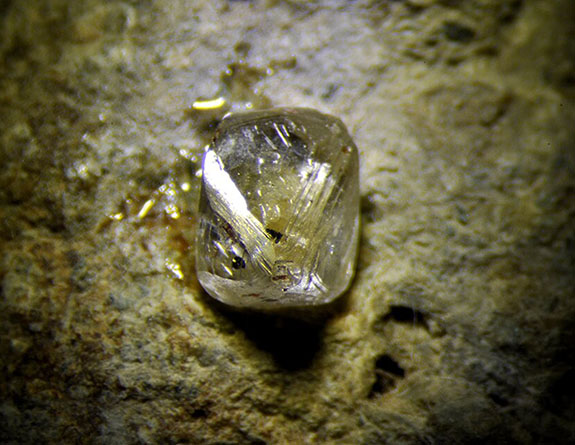Thanks to Olivine Research, the Search for Diamonds Just Got Easier
The excruciatingly difficult task of finding rough diamonds just got a bit easier, thanks to new research that links the most coveted gem on earth with its yellowish-green travelling cousin called olivine, a mineral whose precious form is peridot.

Geologists from ETH Zurich and the University of Melbourne recognized a critical distinction between two types of olivine, which happens to be a key ingredient in kimberlite pipes, the molten rock that blasts diamonds from deep within the Earth to the surface.
The scientists learned that when olivine contains a high concentration of iron, diamonds are less likely to be in the mix. If the olivine contains high concentrations of magnesium, there's a high likelihood that diamonds will be present.
Diamond mining giant De Beers, which helped fund the study and supplied the scientists with kimberlite samples, is already reaping the benefits of this new, streamlined method of finding rough diamond resources.
“Diamond producers sometimes wish they were mining gold, copper or some other raw material, because nothing is as complicated as finding and mining diamonds,” stated Andrea Giuliani, Senior Scientist at ETH Zurich’s Institute of Geochemistry and Petrology. “There’s no method that guarantees that you will find diamonds.”
His team's breakthrough finding relies on how the chemical composition of olivine can become altered 150 kilometres below the Earth's surface.
When melt from underlying layers infiltrates the lithospheric mantle (just below the Earth's crust), it makes the olivine richer in iron. The melt also destroys diamonds.
When only a small amount of melt or no melt can penetrate the lithospheric mantle, the olivine will contain more magnesium and diamonds will remain intact.
“Just looking for a kimberlite is like looking for a needle in a haystack,” Giuliani explained. “Once you’ve found it, then the arduous search for diamonds really gets underway.”
Now miners can inspect kimberlite samples for magnesium-rich olivine and be confident that diamonds are nearby.
The study was recently published in Nature Communications.
Credit: Image by Parent Géry, Public domain, via Wikimedia Commons.

Geologists from ETH Zurich and the University of Melbourne recognized a critical distinction between two types of olivine, which happens to be a key ingredient in kimberlite pipes, the molten rock that blasts diamonds from deep within the Earth to the surface.
The scientists learned that when olivine contains a high concentration of iron, diamonds are less likely to be in the mix. If the olivine contains high concentrations of magnesium, there's a high likelihood that diamonds will be present.
Diamond mining giant De Beers, which helped fund the study and supplied the scientists with kimberlite samples, is already reaping the benefits of this new, streamlined method of finding rough diamond resources.
“Diamond producers sometimes wish they were mining gold, copper or some other raw material, because nothing is as complicated as finding and mining diamonds,” stated Andrea Giuliani, Senior Scientist at ETH Zurich’s Institute of Geochemistry and Petrology. “There’s no method that guarantees that you will find diamonds.”
His team's breakthrough finding relies on how the chemical composition of olivine can become altered 150 kilometres below the Earth's surface.
When melt from underlying layers infiltrates the lithospheric mantle (just below the Earth's crust), it makes the olivine richer in iron. The melt also destroys diamonds.
When only a small amount of melt or no melt can penetrate the lithospheric mantle, the olivine will contain more magnesium and diamonds will remain intact.
“Just looking for a kimberlite is like looking for a needle in a haystack,” Giuliani explained. “Once you’ve found it, then the arduous search for diamonds really gets underway.”
Now miners can inspect kimberlite samples for magnesium-rich olivine and be confident that diamonds are nearby.
The study was recently published in Nature Communications.
Credit: Image by Parent Géry, Public domain, via Wikimedia Commons.

